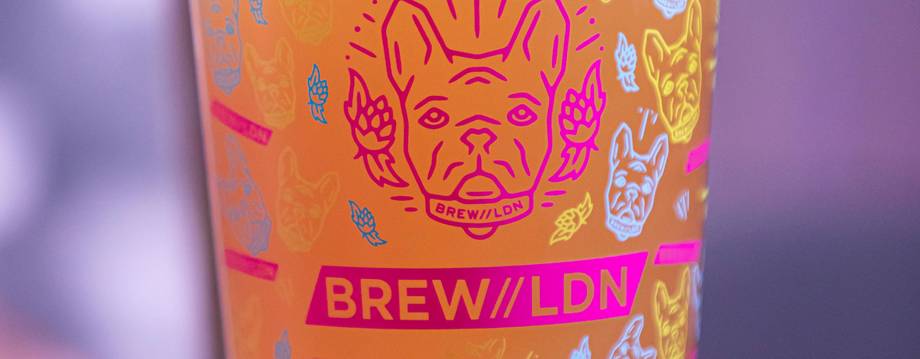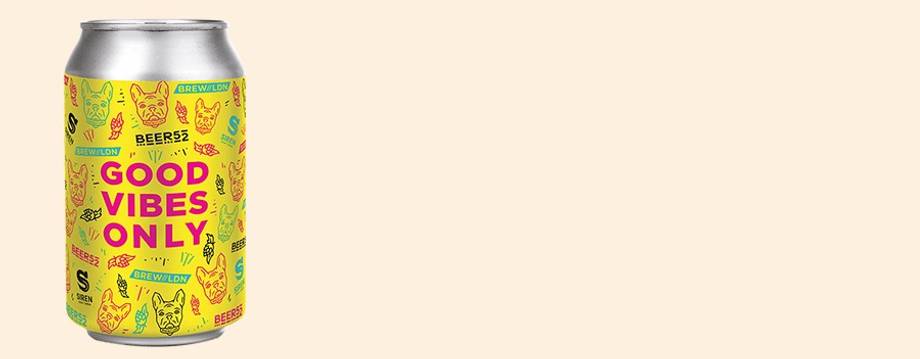Brew//LDN x Siren
The spirit of the party, in a can
Robyn Gilmour
Photos: Brew//LDN
Saturday 08 April 2023

This article is from
Siren's 10th Birthday
issue 90
Share this article
It’s easy to forget when talking about innovation and ingredients, technology and collaboration, that no matter the esteem of a given brewery, craft beer is all about the relationship between brewer and drinker. That special relationship does not diminish the contributions of sectors supporting our own though; one only has to consider the challenges of the past couple of years to know that without hospitality, farming, science, engineering and logistics, we’d all – to put it lightly – be totally fucked.
No aspect of our industry is more keenly aware of the interplay between these entities than craft beer festivals. These occasions are so specifically designed to facilitate the exchange of ideas that, when they work well, the hard work behind them is destined to go unnoticed. Brew//LDN now operates on such a monumental scale as to suggest there’s a fleet of corporate giants behind it, when in reality, the backbone of this craft beer institution is just three guys; Chris Bayliss, Jack Fallon and Toby Chantrell.
Their journey to Brew//LDN is at once simple and complicated, just as their intentions for the event have always been both ordinary and ground breaking. The pair first worked together at a trade-focused events company that they started 10 years ago and ran with their business partner Daniel Rowntree. Initially, the company wasn’t particularly booze-focused but with Daniel coming from a background in the drinks industry, his connections resulted in a lot of their clients being spirits companies, and the business became known for its success in this sector.

As time went on, and craft beer began to find footing in the UK, Chris got increasingly involved in the movement, eventually helping to found Big Hug Brewing Co while balancing work on events. “People were starting to make better beers,” says Chris, “and better breweries were starting up with products that were changing the game in this country. Craft in America was then already booming, but as it became obvious we were just a few years behind, it occurred to us that we didn’t really do anything [events] for ourselves.”
Chris and Toby agreed that jumping on the American bandwagon was not their intention. The UK scene was still developing, and in time would settle on its own set of interests and priorities. Not only would blindly following the American model be premature, but promotional beer events were then a far cry from the sizable festival the guys wanted to organise.
Aside from aspiring to “get away from the whole turn-up-at-a-pub-and-give-some-drinks-away type of activity” that was then the most common way of promoting beer brands, Chris and Toby wanted to use their combined skills and experience to produce an event that a wide variety of consumers might want to attend. After scoping out some early iterations of beer festivals to see what existing events were all about, Chris and Toby immediately recognised that these experiences and spaces catered almost exclusively to just one kind of beer drinker.
They decided they wanted any events they held to be frequented by a wider variety of ages, genders, communities and beer drinkers. In simple terms, “what we’ve always ultimately wanted to do with these events is bring better beer to more people,” says Toby. With the intention of the festival being, as Chris adds, “to bring new audiences to beer, and new beer to audiences,” the pair recognised that to achieve this, they would also have to make the environment one that breweries could shine in.
It’s been great to see breweriesuse the space to secure deals with all kinds of stockists
Obviously, Brew//LDN as we know it today is split into trade and consumer sessions, with the latter being an opportunity for brands to engage with drinkers, and the former providing a chance for breweries to meet buyers. “We cannot stress enough the importance of getting the trade part right,” says Chris. “You can make your order book for the year at the show if you get it right, and in that regard it’s been great to see breweries use the space to secure deals with all kinds of stockists.”
For all the current economic climate is now making events like Brew//LDN more crucial to breweries’ survival than ever, it has also squeezed breweries’ budgets for attending such events. To combat this, Toby says Brew//LDN has “tried to bring in as many different initiatives as possible to help breweries come to the show, even if they're not quite at the stage of being able to afford a stand of their own.
“For example, this year we’ve got an ‘introducing’ bar, basically where breweries can give us some stock, we give them two lines and the revenue we make on the bar covers the cost of their presence at the trade sessions. That way breweries can get their brand out there and be part of the show on a consumer-facing front, but also can still be in the room where all the buyers will be. The result is that everyone brings their A-game, making the event an exciting one for consumers and both a creative and commercially useful opportunity for breweries.”

Of course, while Brew//LDN has been designed and is run with fairness and accessibility in mind, it has equally faced challenges on this front. “Over the last couple of years, we've been very aware that sometimes people don't feel that comfortable in beer spaces,” says Toby. Chris adds that while he and Toby have always consulted with diversity champions, like Melissa Cole, and more recently Kimberly Owen, when planning and reviewing Brew//LDN events, the festival has increased its efforts to stay abreast of how it can best make staff, speakers, and attendees feel welcome, safe, and respected.
“You can’t control people’s actions” says Chris, “but as managers of events we’re responsible if someone’s not having a good time. While it can be quite disheartening if and when that happens, we just have to ensure there are processes in place to deal with any situations that arise as quickly as possible. Saying that, over the last number of years in particular, you also get a feeling now that the craft beer community in general isn't going to accept behaviour that makes other people feel uncomfortable, we’re all out here to support and look out for each other”.
We collaborated and spoke with Brew//LDN on this occasion to celebrate their brewing a beer with Beer52 and Siren Craft Brew in honour of Siren’s 10th Birthday. To mark the occasion, and further celebrate the relationship between brewer and drinker, we asked Siren’s Head Brewer, Sean Knight, to supply us with a home brew recipe for the Single Malt And Single Hop Pale Ale featuring in this month’s box.

Good Vibes Only - SMASH Pale Ale
Malt: 100% Extra Pale Ale Malt | Hops: 100% Citra
Starting Plato: 11.5 | Finishing Plato: 2.0
ABV:5.0% | IBU: 25
Hops in kettle: Citra T90 pellets, at 2.5g/litre (Whirlpool cool to 75°C)
Dry hop: One dry hop charge @ 6.0g/l (Citra T90 @ 5.0 g/l and Citra Cryo @1.0 g/l) Temperature: 18°C
Method
With this recipe, we wanted to build some body and structure in the mouthfeel – sometimes lacking in a single malt beer. So, we have a thicker mash, with a grist-to-water ratio of 1:2.35 and mash temperature of 68.5C.
- Hot-side hops are added in a cooler whirlpool of 75C, which helps to minimise the bitterness.
- For the dry hop, we have used a combination of Citra T90 and Citra Cryo, to drive some aroma intensity and complexity in this single-hop recipe.
- For water, we have gone with 2:1 ratio of Cl2:SO4 ions, to create a softer and smoother mouthfeel for this5.0% pale ale.
- Yeast-wise we’ve gone for our house Vermont yeast, which adds some esters and stone fruit character.
Sean’s top tips for brewing a SMASH Pale Ale:
With the hops, play around with different hop products of that variety. For example Use Citra T90 pellets as well as Citra Cryo pellets. And also look at the different stages of adding the hops from the Mash Tun to get survivable compounds for yeast bio transformation all the way through to Dry Hopping to get aroma intensity.
For the malt, remember to play around with different mash conditions which can lead towards either a sweeter or a drier beer. This will need to be balanced with the hop bitterness. Depending on your mash conditions you can also affect the mouthfeel of the beer.
The other two ingredients (Water and Yeast) are often not at the for front of discussions on ingredients, but a SMASH Pale Ale is the perfect beer to explore new yeast strains or play with different mineral compositions in your water. Both of these can have really big impacts on the finished beer and this can be a great way to explore these other two ingredients.
Share this article

